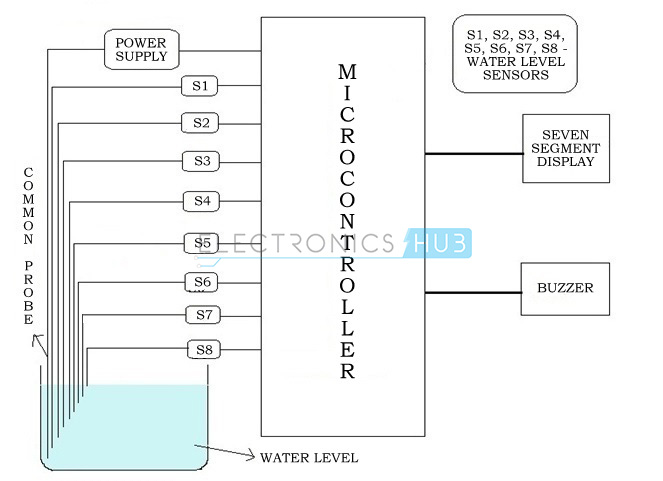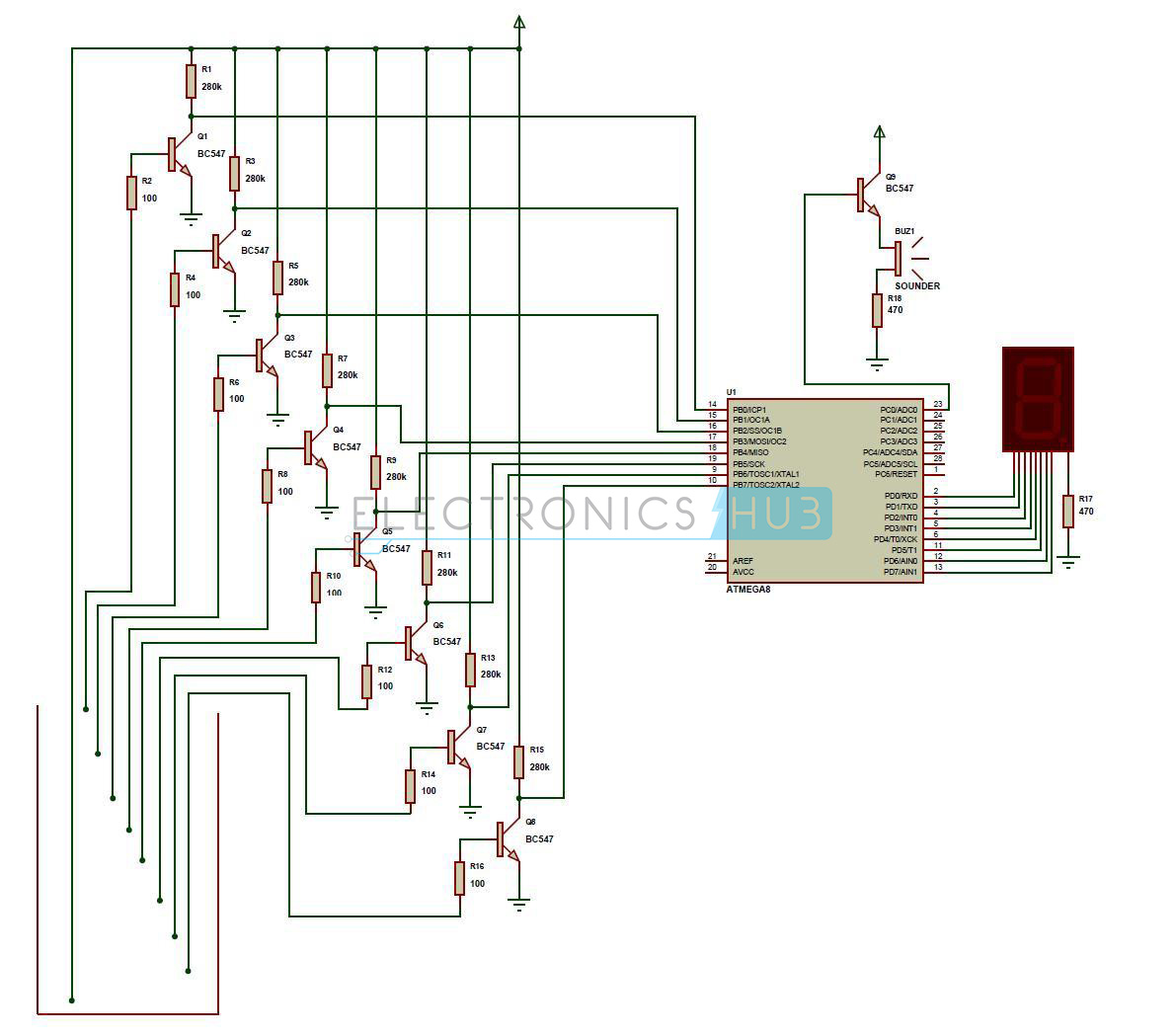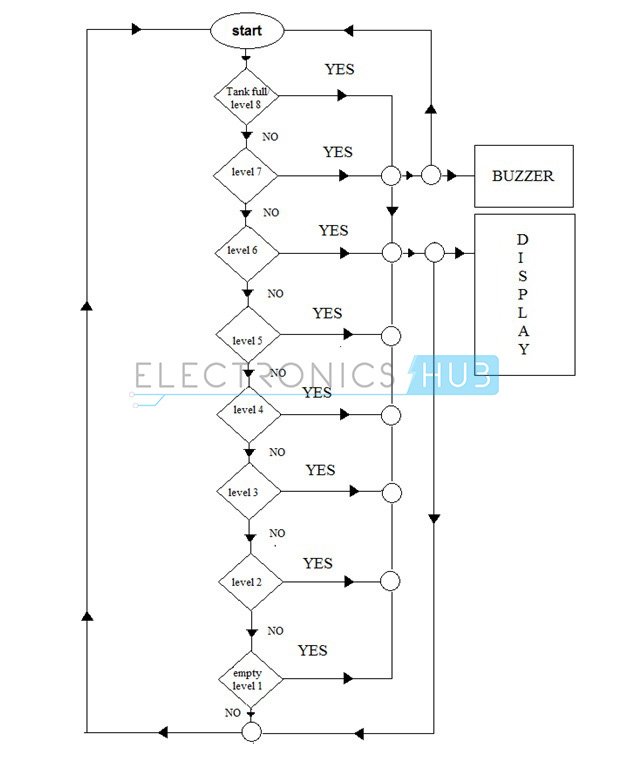The Water Level Indicator employs a
simple mechanism to detect and indicate the water level in an overhead
tank or any other water container. The sensing is done by using a set of
nine probes which are placed at nine different levels on the tank walls
(with probe9 to probe1 placed in increasing order of height, common
probe (i.e. a supply carrying probe) is placed at the base of the tank).
The level 9 represents the “tank full” condition while level 1
represents the “tank empty” condition.
When the water-level is below the
minimum detectable level (MDL), the seven segment displays is arranged
to show the digit 1, indicating that the tank is empty, When the water
reaches level1 (but is below level2) the connection between the probes
gets completed (through the conducting medium – water) and the base
voltage of transistor increases. This causes the base-emitter junction
of transistor to get forward biased, this switches transistor from
cut-off to conduction mode thus PIN (B0) of microcontroller is pulled to
ground hence, the corresponding digit displayed by the seven segment
display is 2. The similar mechanism applies to the detection of all the
other levels. When the tank is full, all inputs to microcontroller
become low and all its outputs go high. This causes the display shows a 9
also in this case a buzzer sound is given, thereby indicating a “tank
full” condition.
Most water level indicators are equipped
to indicate and detect only a single level. The Water Level Indicator
implemented here can indicate up to nine such levels and the
microcontroller displays the level number on a seven segment display.
So, not only is the circuit capable of cautioning a person that the
water tank has been filled up to a certain level, it also indicates that
the water level has fallen below the minimum detectable level. This
circuit is important in appliances such as the water cooler where there
is a danger of motor-burnout when there is no water in the radiator used
up also it can be used in fuel level indication.
Water Level Indicator Project Features:
- Easy installation.
- Low maintenance.
- Compact elegant design.
- The Automatic water level controller ensures no overflows or dry running of pump there by saves electricity and water.
- Avoid seepage of roofs and walls due to overflowing tanks.
- Fully automatic, saves man power.
- Consume very little energy, ideal for continuous operation.
- Automatic water level controller provides you the flexibility to decide for yourself the water levels for operations of pump set.
- Shows clear indication of water levels in the overhead tank.
Hardware Description:
Water Level Indicator Project Block Diagram:
Figure 2.1.1 Block diagram
Water Level Indicator Project Circuit Diagram:
Water Level Indicator Project Description:
This is the circuit diagram and description for water level indicator.
- A constant 5v power supply is given to the microcontroller and rest of the circuit from a battery.
- The tank has 9 conductive type sensors (other types of sensors have been mentioned earlier but in our project only conductive type are used) embedded into it and 8 wires of sensors out of 9 are connected to transistors and the 9th is connected to 5v+ supply.
- The use of transistor is it acts as inverter (i.e. in on state gives low voltage at output and in non conducting state gives high voltage at its output), all transistors outputs are connected to 1,2,3,4,5,6,7,8 pins (PORTB) of microcontroller.
- Seven segment display is connected to pin no. 33 to 40 (PORTA). It is connected in common cathode fashion.
The Output for the 7th level is not only shown in seven segment display but also indicated with a discontinuous buzzer sound. - Output for the 8th level (i.e. tank full condition) is not only shown in seven segment display but also indicated with a continuous buzzer sound.
Operation:
The operation of this project is very
simple and can be understood easily. In our project “water level
indicator” there are 3 main conditions:
- There is no water available in the source tank.
- Intermediate level i.e. either of 3rd to 7th level.
- There is ample amount of water available in the source tank.
So let us discuss on the more about these 3 conditions
CONDITION 1: Water not available
When the tank is empty there is no
conductive path between any of the 8 indicating probes and the common
probe (which is connected to 5v+ supply) so the transistor base emitter
region will not have sufficient biasing voltage hence it remains in cut
off region and the output across its collector will be Vc approximately
4.2v. As in this case the microcontroller is used in the active low
region (which means it considers 0-2 volts for HIGH and 3-5 volts for
LOW) now the output of transistor which is 4.2v approximately will be
considered as LOW by the microcontroller and hence the default value
given by microcontroller to the seven segment display is 1 which
indicates as the tank is empty.
CONDITION 2: Intermediate levels
Now as the water starts filling in the
tank a conductive path is established between the sensing probes and the
common probe and the corresponding transistors get sufficient biasing
at their base, they starts conducting and now the outputs will be Vce
(i.e. 1.2v-1.8v) approximately which is given to microcontroller. Here
the microcontroller is programmed as a priority encoder which detects
the highest priority input and displays corresponding water level in the
seven segment display. In this project while the water level reaches
the 7th level i.e. last but one level along with display in seven
segment a discontinuous buzzer is activated which warns user that tank
is going to be full soon.
CONDITION 3: Water full
When the tank becomes full, the top
level probe gets the conductive path through water and the corresponding
transistor gets into conduction whose output given to microcontroller
with this input microcontroller not only displays the level in seven
segment display but also activates the continuous buzzer by which user
can understand that tank is full and can switch off the motor and save
water.
Flow Chart:
Flow chart gives the clear and easy understanding of the project. The process goes on as follows:
The microcontroller checks if the tank is full if the condition is satisfied it indicates the same on display unit and also sounds a buzzer if the condition fails it checks if the tank is filled upto level 7 and this process continues and the corresponding level is indicated in the display unit.
The microcontroller checks if the tank is full if the condition is satisfied it indicates the same on display unit and also sounds a buzzer if the condition fails it checks if the tank is filled upto level 7 and this process continues and the corresponding level is indicated in the display unit.
Conclusion and Scope:
Applications of Water Level Indicator:
- Automatic Water level Controller can be used in Hotels, Factories, Homes Apartments, Commercial Complexes, Drainage, etc., It can be fixed for single phase motor, Single Phase Submersibles, Three Phase motors. (For 3Æ and Single Phase Submersible Starter is necessary) and open well, Bore well and Sump. We can control two motor and two sumps and two overhead tanks by single unit.
- Automatic water level controller will automatically START the pump set as soon as the water level falls below the predetermined level (usually 1/2 tank) and shall SWITCH OFF the pump set as soon as tank is full.
- Fuel level indicator in vehicles.
- Liquid level indicator in the huge containers in the companies.





0 comments:
Post a Comment